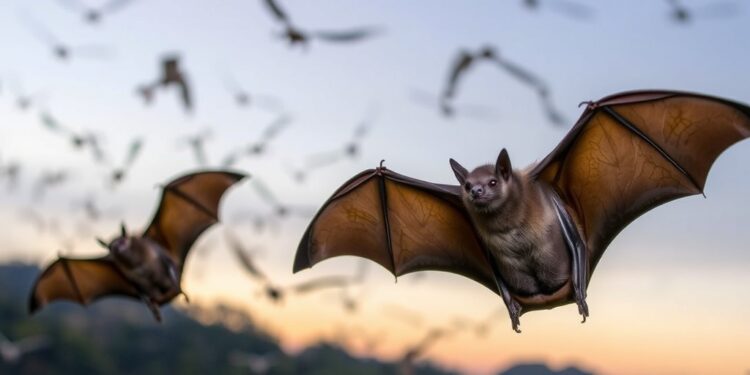A groundbreaking study has revealed fascinating insights into the migratory behavior of bats, particularly the common noctule bat, which has exhibited an extraordinary ability to exploit meteorological conditions during its seasonal migrations across central Europe. Researchers utilized innovative biotelemetry techniques to track the movements of these remarkable creatures, uncovering their unique strategy of “surfing” warm winds associated with incoming storm fronts to minimize energy expenditure. This phenomenon not only highlights the intricate relationship between weather patterns and bat migration but also sheds light on the physiological and environmental factors that influence their long-distance journeys.
At the heart of this groundbreaking research is the development of a cutting-edge biotelemetry technology that utilizes 1.2-gram Internet of Things (IoT) tags, which are small enough to be affixed to the bats without hindrance. The tags, connected to a 0G wireless network, are capable of collecting and transmitting vital data, including the bats’ location, activity levels, and environmental temperature. This technological advancement has allowed researchers to track 71 female common noctule bats during their annual spring migrations, providing unprecedented access to real-time data on their movements.
The study, led by Edward Hurme and his team, observed that these bats traversed impressive distances, covering up to 1,116 kilometers over the span of 46 days. Remarkably, the bats were recorded making single-night flights as long as 383 kilometers, significantly surpassing previously documented migration distances. The data showed a clear preference among the bats to time their journeys toward maternity roosts in alignment with warm nights and the approach of storm fronts. By effectively utilizing the tailwinds created by these atmospheric conditions, the bats can significantly reduce their energy demands.
However, the analysis also uncovered another layer of complexity in bat migration. While many bats displayed a remarkable ability to adapt their migration timing to suit varying weather conditions, female bats migrating later in the season faced increased energy costs. This was primarily due to two factors: the weight added during pregnancy and the diminishing availability of favorable winds and weather. The findings indicate that these bats possess a high degree of flexibility in their migration behavior, enabling them to adjust their strategies in response to changing environmental contexts.
In addition to the immediate implications of these findings for our understanding of migratory patterns in bats, they raise critical concerns regarding the future of these species in the face of ongoing environmental change. The ability of bats to navigate and migrate successfully is intricately tied to the ecological dynamics of their habitats, including the availability of food resources and the impact of climate variability. As weather patterns shift and ecosystems undergo transformations, the consequences for migratory routes and behaviors could be dire, potentially exacerbating the challenges that bats already encounter.
Emerging research has indicated that bat populations may face significant threats from anthropogenic influences and the ongoing decline of insect populations—a primary food source for these creatures. With the integration of advanced tracking technologies, researchers are now in a better position to unravel the complexities of bat migration, examine their foraging behaviors, and understand the broader ecological implications of their movements.
However, as noted by Liam McGuire in a related perspective, the findings serve as a clarion call for action. Without decisive measures to combat the numerous threats faced by bat populations, including habitat loss, climate change, and declining insect availability, the very future of these remarkable animals remains uncertain. The study underscores the critical importance of protecting bat habitats and implementing conservation strategies that account for their unique migratory behaviors.
As we delve further into the intricacies of bat migration, this research illuminates the profound interconnectedness of weather patterns, animal physiology, and ecological health. Scientists are now equipped with new tools to explore these previously opaque aspects of bat life, paving the way for more comprehensive conservation efforts. Ultimately, understanding and addressing the vulnerabilities of these migratory species is not just essential for their survival but also for the broader health of the ecosystems they inhabit.
In conclusion, the exploration of the migratory behaviors of common noctule bats highlights the remarkable adaptability of these creatures in the face of environmental challenges. As we continue to unveil the mysteries of bat migration, this research illustrates the pressing need for a united approach to conservation, ensuring these fascinating animals remain a vital component of our natural world. The revelations brought forth by this study serve as both an inspiration and a warning, urging continued exploration while advocating for the protection of vulnerable species.
Subject of Research: Migratory behavior of common noctule bats
Article Title: Bats surf storm fronts during spring migration
News Publication Date: 3-Jan-2025
Web References: http://dx.doi.org/10.1126/science.ade7441
References: Not provided
Image Credits: Not provided
Keywords
Bat migration, common noctule bat, biotelemetry, energy conservation, climate change, ecological health, conservation strategies.





